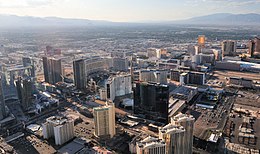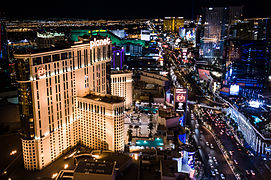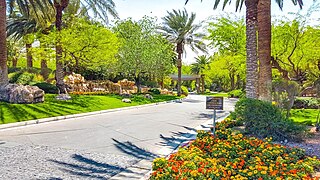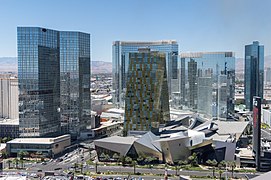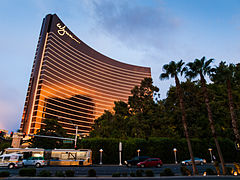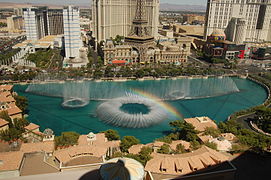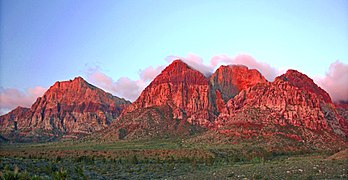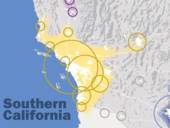|
Las Vegas Valley
The Las Vegas Valley is a major metropolitan area in the southern part of the U.S. state of Nevada, and the second largest in the Southwestern United States. The state's largest urban agglomeration, the Las Vegas Metropolitan Statistical Area is coextensive since 2003 with Clark County, Nevada.[2] The Valley is largely defined by the Las Vegas Valley land formation, a 600 sq mi (1,600 km2) basin area surrounded by mountains to the north, south, east and west of the metropolitan area. The Valley is home to the three largest incorporated cities in Nevada: Las Vegas, Henderson and North Las Vegas.[3] Eleven unincorporated towns governed by the Clark County government are part of the Las Vegas Township and constitute the largest community in the state of Nevada.[4] The names Las Vegas and Vegas are interchangeably used to indicate the Valley, the Strip, and the city, and as a brand by the Las Vegas Convention and Visitors Authority to denominate the region.[5][6] The Valley is affectionately known as the Ninth Island by Hawaii natives and Las Vegans alike, in part due to the large number of people originally from Hawaii who live in and regularly travel to Las Vegas.[7] Since the 1990s, the Las Vegas Valley has seen rapid growth, tripling its population from 741,459 in 1990 to 2,227,053 estimated in 2018, increasing to 2,953,000 in 2024.[8] The Las Vegas Valley remains one of the fastest growing metropolitan areas in the United States. In its relatively short history, it has established a diverse presence in international business, commerce, urban development, and entertainment, as well as one of the most visited tourist attractions destinations in the world. In 2014, a record-breaking 41 million people visited the Las Vegas area, producing a gross metropolitan product of more than $100 billion.[9] HistoryThe first reported non-Native American visitor to the Las Vegas Valley was the Mexican scout Rafael Rivera in 1829.[10][11][12] Las Vegas was named by Mexicans in the Antonio Armijo party,[4] including Rivera, who used the water in the area while heading north and west along the Old Spanish Trail from Texas. In the 19th century, areas of the valley contained artesian wells that supported extensive green areas, or meadows, hence the name Las Vegas (vegas being Spanish for "meadows").[11] The area was previously settled by Mormon farmers in 1854 and later became the site of a United States Army fort in 1864, beginning a long relationship between southern Nevada and the U.S. military. Since the 1930s, Las Vegas has generally been identified as a gaming center as well as a resort destination, primarily targeting adults. Nellis Air Force Base is located in the northeast corner of the valley. The ranges that the Nellis pilots use and various other land areas used by various federal agencies, limit growth of the valley in terms of geographic area. Businessman Howard Hughes arrived in the late 1960s and purchased many casino hotels, as well as television and radio stations in the area. Legitimate corporations began to purchase casino hotels as well, and the mob was run out by the federal government over the next several years. The constant stream of tourist dollars from the hotels and casinos was augmented by a new source of federal money from the establishment of what is now Nellis Air Force Base. The influx of military personnel and casino job-hunters helped start a land building boom which is now leveling off.[according to whom?] The Las Vegas area remains one of the world's top entertainment destinations.[13][14] BoundariesThe valley is contained in the Las Vegas Valley landform. This includes the cities of Las Vegas, North Las Vegas, and Henderson, and the unincorporated towns of Summerlin South, Paradise, Spring Valley, Sunrise Manor, Enterprise, Winchester, and Whitney. The valley is located within the larger metropolitan area, as the metropolitan area covers all of Clark County including parts that do not fall within the valley. The government of Clark County has an "Urban Planning Area" of Las Vegas. This definition is a roughly rectangular area, about 20 mi (32 km) from east to west and 30 miles (48 km) from north to south. Notable exclusions from the "Urban Planning Area" include Red Rock, Blue Diamond, and Mount Charleston. The Las Vegas Metropolitan Police Department is the largest police department in the valley and the state and exercises jurisdiction in the entire county. There are approximately 3,000 police officers who cover the city of Las Vegas; unincorporated areas; the town of Laughlin, about 90 mi (140 km) from Downtown Las Vegas; and desert, park, and mountain areas within Clark County. The department does not exercise primary jurisdiction in areas with separate police forces such as North Las Vegas, Henderson, Boulder City, Nellis Air Force Base and the Paiute reservation. The metropolitan area was created for the 1970 census when it only included Clark County. In 2000, the metropolitan area was changed to include Nye County, Nevada, and Mohave County, Arizona,[15][16][17] but it later returned to only being Clark County. The Office of Management and Budget has designated Clark County as the Las Vegas-Henderson-Paradise, NV Metropolitan Statistical Area.[18] The United States Census Bureau ranked the Las Vegas-Henderson-Paradise, NV Metropolitan Statistical Area as the 31st most populous metropolitan statistical area of the United States as of July 1, 2012.[19] The Office of Management and Budget has further designated the Las Vegas-Henderson-Paradise, NV Metropolitan Statistical Area as a component of the more extensive Las Vegas–Henderson, NV–AZ CSA,[18] the 27th most populous combined statistical area and the 30th most populous primary statistical area of the United States as of July 1, 2012.[19][20] Geography and environment  The Las Vegas Valley lies in the Mojave Desert. The valley in the northwest section is a northwest-by-southeast[21] trending area, and trending parallel to Las Vegas Wash, lies at the northeast of the Spring Mountains massif. U.S. Route 95 leaves Las Vegas's northwest and goes northwesterly through the northwest valley section, with Las Vegas Wash about 2 miles (3 km)[22] northeast. U.S. 95 lies on the southwest perimeter of the valley bottomlands, and small alluvial fan areas from the northeast Spring Mountains border southwest. A "distorted surface",[23] a playa-like region, occurs at the farthest northwest area, for about 15 to 18 miles (24 to 29 km), starting from Nevada Route 157. At Nevada Route 156, 10 miles (16 km) northwest, the distorted surface, bottom land turns north, a 6 miles (9.7 km) area in length and about 3 miles (4.8 km) wide. It lies at the south drainage section of the Three Lakes Valley, where a water divide separates Dog Bone Lake in the valley's center from the southwest washes that drain into the Las Vegas Valley (upland Las Vegas Wash). The Corn Creek Dunes lie about 5 miles (8.0 km) southwest of Route 156's intersection with U.S. 95, and they are slightly northeast of Las Vegas Wash. The Las Vegas Valley is around 1,600 square miles (4,100 km2).[24] All perimeters, except the northwest, are foothills or mountain ranges, with all highway routes entering the foothills; this includes the Interstate 15 to the southwest, as it climbs to Jean Pass (north), before traversing Ivanpah Valley. Only the U.S. Route 95 northwest follows an actual valley. The northwest section, thus describes the entire landform as a central, and large valley with an attached feeder valley northwest, and in this case the northwest source, and actual course of the Las Vegas Wash. The valley is a fault-bounded structural and hydrologic basin[25] made of alluvial-fan deposits. There are several aquifers contained within the valley including the Las Vegas Aquifer. These heavily depleted water sources exist at about 660–980 feet (200–300 m) in depth.[25] As of 1986, estimate show that the valley floor in Downtown Las Vegas has subsided by about 6.2 feet (1.9 m) and about 2.9 feet (0.88 m) along The Strip as a result of pumping from these aquifers.[26] ClimateThe Las Vegas Valley lies in a relatively high-altitude portion of the Mojave Desert, with a subtropical hot-desert climate. The Valley generally averages less than 5 in (130 mm) of rain annually.[27] Daily daytime summer temperatures in July and August typically range from 100 °F (38 °C) to 110 °F (43 °C), while nights generally range from 72 °F (22 °C) to 80 °F (27 °C).[27] Very low humidity, however, tempers the effect of these temperatures, though dehydration, heat exhaustion, and sun stroke can occur after even a limited time outdoors in the summer. The interiors of automobiles often prove deadly to small children and pets during the summer and surfaces exposed to the sun can cause first- and second-degree burns to unprotected skin. July and August can also be marked by monsoon season, when moist winds from the Gulf of California soak much of the Southwestern United States. While not only raising humidity levels, these winds develop into dramatic desert thunderstorms that can sometimes cause flash flooding. Winter days in metropolitan Las Vegas range from mild to quite chilly, and sunny most days; while winter itself is of short duration. Winter highs in December and January usually range from 52 °F (11 °C) to 60 °F (16 °C), while nighttime lows range from 34 °F (1 °C) to 42 °F (6 °C).[27] The mountains surrounding the valley are snow-covered during the winter season, but snow accumulation in the metropolitan area itself is uncommon. Every few years apart, however, Las Vegas does get a small measurable snowfall. Spring and fall are generally dry and with hot, sunny days and cool nights.
Fault zonesThe valley is an active earthquake zone crossed by multiple fault and thrust lines. These include the 20-mile (32 km) long Frenchman Mountain Fault capable of a magnitude 7 event, Whitney Mesa Fault, Cashman Fault, Valley View Fault, Decatur Fault, Eglington Fault and the West Charleston Fault.[30][31][32][33] Air qualityHaving part of the region in a desert basin creates problems with air quality. From the dust the wind picks up, to the smog produced by vehicles, to the pollen in the air, the valley has several bad air days. Pollen can be a major problem several weeks a year, with counts occasionally in the 70,000-plus range. Local governments are trying to control this by banning plants that produce the most pollen. The dust problems usually happen on very windy days, so they tend to be short and seasonal. Full-fledged dust storms are rare. Smog, on the other hand, gets worse when there is no wind to move the air out of the valley. Also, in winter it is possible for an inversion to form in the valley. Since manufacturing is not a dominant industry of Las Vegas, and with Clark County working to control air quality problems, success has been shown over the years. Water The native flora does little to help the soil retain water. During the intense rains of monsoon season or (relatively) wet months of January and February, a network of dry natural channels, called washes or arroyos, carved into the valley floor allows water to flow down from the mountains and converge in the Las Vegas Wash which runs through the Clark County Wetlands Park. The wash system used to form a large natural wetlands which then flowed into the Colorado River, until the construction of Hoover Dam on the Colorado River led to the creation of Lake Mead. Further development in the 1980s and 1990s made Lake Las Vegas, which required directing the Las Vegas Wash into tunnels which run under Lake Las Vegas and into Lake Mead. Nevada receives an allocation 300,000 acre-feet (370,000,000 m3) of water[34] each year from Lake Mead, with credits for water it returns to the lake. The allocations were made with the Colorado River Compact when Nevada had a much smaller population and very little agriculture. The allocations were also made during a wet string of years, which overstated the available water in the entire watershed. As a result, precipitation that is below normal for a few years can significantly affect the Colorado River reservoirs. The Las Vegas area uses most of this allocation with Laughlin, Nevada using most of the remaining allocation. In June 2007, the price of a cubic meter was 57 cents in Las Vegas.[35] Las Vegas gets around 90 percent of its water from Lake Mead.[36] Early Vegas depended on the aquifer which fed the flowing springs supporting the meadows that gave the area its name, but the pumping of water from these caused a large drop in the water levels and ground subsidence over wide areas of the valley. Today, the aquifers are basically used to store water that is pumped from the lake during periods of low demand and pumped out during periods of high demand. UrbanizationThe population doubling time in the greater metropolitan area was under ten years, since the early 1970s and the Las Vegas metropolitan area now has a population approaching three million people.[8] This rapid population growth led to a significant urbanization of desert lands into industrial and commercial areas (see suburbia). EconomyThe driving force in Las Vegas is the tourism industry and the area has about 150,000 hotel rooms, more than any other city in the world.[37] In the past, casinos and celebrity shows were the two major attractions for the area. Now shopping, conventions, fine dining, and outdoor beauty [clarification needed] are also major forces in attracting tourist dollars. Las Vegas serves as world headquarters for the world's largest Fortune 500 gaming company, MGM Resorts International.[38] Several companies involved in the manufacture of electronic gaming machines, such as slot machines, are located in the Las Vegas area. In the first decade of the 21st century, shopping and dining have become attractions of their own. Tourism marketing and promotion are handled by the Las Vegas Convention and Visitors Authority, a county-wide agency. Its annual Visitors Survey provides detailed information on visitor numbers, spending patterns, and resulting revenues.[39]   While Las Vegas has historically attracted high-stake gamblers from around the world, it is now facing tougher competition from the UK, Hong Kong and Macau (China), Eastern Europe and developing areas in the Middle East.[40] Las Vegas has recently enjoyed a boom in population and tourism. The urban area has grown outward so quickly that it borders Bureau of Land Management holdings along its edges. This has led to an increase in land values such that medium- and high-density development is occurring closer to the core. The Chinatown of Las Vegas was constructed in the early 1990s on Spring Mountain Road. Chinatown initially consisted of only one large shopping center complex, but the area was expanded with shopping centers that contain various Asian businesses. Over the past few years, retirees have been moving to the metro area, driving businesses that support them from housing to health care. While the cost of housing spiked up over 40% in 2004, the lack of business and income taxes still makes Nevada an attractive place for many companies to relocate to or expand existing operations. Being a true twenty-four-hour city, call centers have always seemed to find Las Vegas a good place to hire workers who are accustomed to working at all hours.[citation needed] The construction industry accounts for a share of the economy in Las Vegas. Hotel casinos planned for the Strip can take years to build and employ thousands of workers. Developers discovered that there was demand for high-end condominiums.[41] By 2005, more than 100 condominium buildings were in various stages of development,[42] however, in 2008, the construction industry went into a downturn due to the Great Recession, though the industry has since seen a rebound. In 2000, more than 21,000 new homes and 26,000 resale homes were purchased. In early 2005, there were 20 residential development projects of more than 300 acres (120 ha) each underway. During that same period, Las Vegas was regarded as the fastest-growing community in the United States. Other promising residential and office developments have begun construction around Downtown Las Vegas. New condominium and high-rise hotel projects have changed the Las Vegas skyline dramatically in recent years. Many large high-rise projects are planned for Downtown Las Vegas, as well as the Las Vegas Strip.[43] Construction Construction in Las Vegas is a major industry and quickly growing with the population. In March 2011, construction employed 40,700 people and is expected to grow with the recovering economy.[44] Since the mega resorts that define Las Vegas today began going up in the early 1970s, construction has played a vital role in both commercial and non commercial developments. Cranes are a constant part of the Las Vegas Skyline. At any given time there are 300 new homes being constructed in Las Vegas.[citation needed] In addition, in recent years [when?] Las Vegas has seen a spike in high-rise housing units. New suburban master planned communities are also becoming common in Las Vegas ever since The Howard Hughes Corporation began work on Summerlin, an upper-class community on the west side of the valley. The massive CityCenter project, by MGM Mirage, broke ground on the Strip in 2006.[45] It put a massive strain on the construction ability and workforce of the area due to number of laborers and amount of materials required. Because of this, prices of almost any construction project in Las Vegas doubled.[citation needed] The project was completed in 2009 and includes multiple hotels and condominiums, as well as shopping and a casino. At a cost of $8.5 billion, it is the most expensive privately funded construction project in U.S. history.[46] The Tropicana Hotel, opened in 1957, will be demolished in April 2025 in order to create a new baseball stadium.[47] Bally's Corporation, the owner of the hotel, indicated that upon completion of the stadium it would further develop the site.[48] HousingTraditionally, housing consisted primarily of single-family detached homes. Slab-on-grade foundations are the common base for residential buildings in the valley. Apartments generally were two-story buildings. Until the 1990s, there were exceptions, but they were few and far between. In the 1990s, Turnberry Associates constructed the first high rise condominium towers. Prior to this, there were only a handful of mid-rise multi-family buildings. By the mid-2000s, there was a major move into high rise condominiums towers, which affected the region's skyline around the Strip. The Las Vegas Valley is home to various suburban master planned communities that include extensive recreational amenities such as lakes, golf courses, parks, bike paths and jogging trails. Planned communities in the valley include Aliante, Anthem, Cadence, Centennial Hills, Green Valley, Inspirada, Lake Las Vegas, The Lakes, Mountain's Edge, Peccole Ranch, Providence, Rhodes Ranch, Seven Hills, Skye Canyon, Southern Highlands, and Summerlin. Technology companies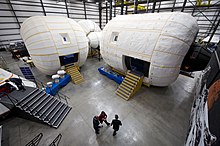 Some technology companies have either relocated to Las Vegas or were created there. For various reasons, Las Vegas has had a high concentration of technology companies in electronic gaming and telecommunications industries.[further explanation needed] Some current technology companies in southern Nevada include: Bigelow Aerospace, Petroglyph, Switch Communications, US Support LLC, Fanatics, and Zappos. In 2015, Electric vehicle startup Faraday Future has chosen North Las Vegas's Apex Industrial Park for its $1 billion car factory. Companies that originally were formed in the Las Vegas region, but have since sold or relocated include Westwood Studios (sold to Electronic Arts), Systems Research & Development (Sold to IBM), Yellowpages.com (Sold to BellSouth and SBC), and MPower Communications. Tourism The major attractions in the Las Vegas Valley are the hotel/casinos. These hotels generally consist of large gambling areas, theaters for live performances, shopping, bars/clubs, and several restaurants and cafes. There are clusters of large hotel/casinos located in both downtown Las Vegas and on the Las Vegas Strip. The largest hotels are mainly located on the Strip,[49] which is a four-mile section of Las Vegas Boulevard. These hotels provide thousands of rooms of various sizes. Fifteen of the world's 30 largest hotels by room count are on the Strip, with a total of over 62,000 rooms. There are many hotel/casinos in the city's downtown area as well, which was the original focal point of the Valley's gaming industry. Several hotel/casinos ranging from large to small are also located around the city and metro area. Many of the largest hotel, casino, and resort properties in the world are located on the Las Vegas Strip. The valley's casinos can be grouped into several locations. The largest is the Las Vegas Strip, followed by Downtown Las Vegas, and then the smaller Boulder Strip. There are also several one-off single standing hotel/casinos dotted around the valley and the metro area. In 2011, the majority of tourists arrived from the western states (55%) with 31% from California alone. Approximately 16% of tourists arrived from outside North America.[50] Shopping Las Vegas has expanded its attractiveness to visitors by offering both affordable and high-end merchandise in many shops and shopping malls. Many hotels on the Las Vegas Strip also have adjacent shopping malls, giving the Las Vegas area the highest concentration of shopping malls in any four mile stretch of road. In addition to the malls on the Strip, there are several outlying malls in the City of Las Vegas, Henderson, and the surrounding area. The monorail, lying somewhat east of the Strip, facilitates north–south travel, including stations at several casinos and the Las Vegas Convention Center. Major shopping attractions include:
ConventionsLas Vegas holds many of the world's largest conventions each year, including CES, SEMA, and Conexpo. The Las Vegas Convention Center is one of the largest in the world with 1,940,631 sq ft (180,290.5 m2) of exhibit space. These events bring in an estimated $7.4 billion of revenue to the city each year, and host over 5 million attendees.[60][61]
Culture and the arts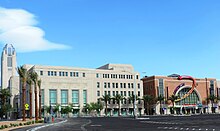  The "First Friday" celebration, held on the first Friday of each month, exhibits the works of local artists and musicians in an area just south of downtown. The city is home to an extensive Downtown Arts District which hosts numerous galleries, film festivals, and events.[62] The Southern Nevada Zoological-Botanical Park, also known as the Las Vegas Zoo, used to exhibit over 150 species of animals and plants. The Zoo closed its doors in September 2013.[63] The Shark Reef Aquarium at Mandalay Bay is the only aquarium that is accredited by the Association of Zoos and Aquariums in the state of Nevada. It features over 2,000 animals and 1,200 species in 1.6 million gallons of seawater. The $485 million Smith Center for the Performing Arts is located downtown in Symphony Park. The center is appropriate for Broadway shows and other major touring attractions as well as orchestral, opera, choir, jazz, and dance performances. Bellagio Gallery of Fine Art is a facility presenting high-quality art exhibitions from major national and international museums. Past exhibits have included the works of Andy Warhol, Alexander Calder, and Peter Carl Fabergé. A self-guided audio tour is also offered. The Las Vegas Natural History Museum features robot dinosaurs, live fish, and more than 26 species of preserved animals. There are several "hands-on" areas where animals can be petted. The Atomic Testing Museum, affiliated with the Smithsonian Institution, houses artifacts from the Nevada Test Site and records the dramatic history of the atomic age through a series of interactive modules, timelines, films, and actual equipment and gadgets from the site. In 2019, The New York Times noted that there was a "burgeoning literary scene" at Las Vegas centered around the Black Mountain Institute, a literature organization at the University of Nevada, Las Vegas, and its literary magazine, The Believer.[64] The valley is home to numerous other art galleries, orchestras, ballets, theaters, sculptures, and museums as well. FestivalsGardens Libraries and bookstores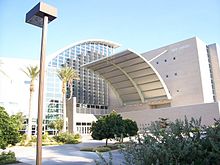 Museums
Parks and attractions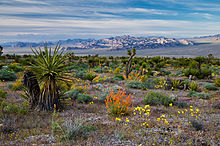 
TheatersWildlifeCommunitiesCitiesLas Vegas neighborhoods
Census-designated places Other communitiesMediaNewspapers
BroadcastLas Vegas is served by 22 television and 46 radio stations. The area is also served by two NOAA Weather Radio transmitters (162.55 MHz located in Boulder City and 162.40 MHz located on Mount Potosi). MagazinesTransportation   Harry Reid International Airport (LAS) provides commercial flights into the Las Vegas Valley. The airport serves domestic, international and cargo flights, as well as some private aircraft. General aviation traffic, however, will typically use the much smaller North Las Vegas Airport or other airfields in the county. Public transportation is provided by RTC Transit. Numerous bus routes cover Las Vegas, Henderson, North Las Vegas and other suburban areas. The Las Vegas Monorail runs from MGM Grand Las Vegas at the south end of the Strip to the Sahara Las Vegas at the north end of the Strip. The street numbering system is divided by the following streets:
Until 1997, the Amtrak Desert Wind train service ran through Las Vegas using the Union Pacific Railroad (UP) rails that run through the city; Amtrak service to Las Vegas has since been replaced by Amtrak's Thruway Motorcoach bus service. Plans to restore Los Angeles to Las Vegas Amtrak service using a Talgo train have been discussed but no plan for a replacement has been implemented. The Las Vegas Amtrak station was located in the Plaza Hotel. It had the distinction of being the only train station located in a casino. Airports
Rail and busWhile the Las Vegas area does not have any passenger rail service, Brightline West intends to revive passenger trains with a high-speed train between the Las Vegas station and the Rancho Cucamonga station in Greater Los Angeles. Las Vegas receives about 30 freight trains per day as of 2004[update], and serves as a district crew change point, requiring all trains to stop in downtown. Freight traffic was 179,284 cars in 2004.[69] Existing servicesResort tramsRoads Two major freeways—Interstate 15 and Interstate 11 (including US 93 and US 95)—cross in downtown Las Vegas. I-15 connects Las Vegas to Los Angeles and San Diego, and heads northeast to Salt Lake City and beyond. I-11 goes northwest to the Las Vegas Paiute Indian Reservation and southeast to Henderson, bypassing downtown Boulder City just to the south, and then to the Mike O'Callaghan–Pat Tillman Memorial Bridge over the Colorado River, from there U.S. Route 93 continues towards Phoenix, Arizona. I-11 will eventually be the connection from Nogales, Arizona to the Reno and Sparks vicinity of either Fernley or at the Reno Spaghetti Bowl in Reno when completed. US 95 connects the city to northwestern Nevada, including Carson City (the state capitol) and Reno. US 93 splits from I-15 northeast of Las Vegas and goes north through the northeastern part of the state, serving Ely and Wells and US 95 heads south from I-11 and US 93 in Boulder City through far southeastern California. A three-quarters of the Las Vegas Beltway has been built, consisting of Interstate 215 on the south and Clark County 215 on the west and north. Other radial routes include SR 160 to Pahrump and SR 147 and SR 564 (former SR 146) to Lake Mead. With the notable exceptions of Las Vegas Boulevard, Boulder Highway and Tonopah Highway (better known as the northern part of Rancho Drive), the majority of surface streets outside downtown Las Vegas are laid out along Public Land Survey System section lines. Many are maintained, in part, by the Nevada Department of Transportation (NDOT) as state highways.
FuelThe Las Vegas area is dependent on imported gasoline, diesel and aviation fuel as is most of Nevada, which has only one refinery. The region is dependent on the Calnev Pipeline and Unev pipeline as its two main sources of supply. Limited diesel is delivered to a dedicated terminal in North Las Vegas by rail. Diversified supply was provided by the completion of construction on the Unev pipeline in 2011 and its full operational status in 2012. ElectricityAbout 25% of the electric power from Hoover Dam goes to Nevada,[71] and about 70% of power to Southern Nevada comes from natural gas fired power stations.[72] Sports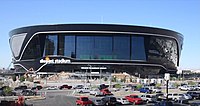   Las Vegas is home to several notable minor league teams, as well as the UNLV Rebels, and three major professional teams, the Las Vegas Raiders of the National Football League, the Vegas Golden Knights of the National Hockey League, and the Las Vegas Aces of the Women's National Basketball Association. The Oakland Athletics of Major League Baseball plan to move to Las Vegas in 2028.
RecreationLas Vegas has many natural outdoor recreational options. There are several multi-use trail systems within the valley operated by multiple organizations. The River Mountains Loop Trail is a 35-mile-long (56 km) trail that connects the west side of the valley with Hoover Dam and Lake Mead.[73] Summerlin offers more than 150 miles of award-winning trails within the 22,500-acre (9,100 ha) community.[74] There are also the 3-mile (4.8 km) Angel Park Trail, Bonanza Trail, and the county's Flamingo Arroyo Trail,[75] I-215 West Beltway Trail (5 miles (8.0 km)), I-215 East Beltway Trail (4 miles (6.4 km)), Tropicana/Flamingo Washes Trail and the Western Trails Park Area Equestrian Trails (4 miles).[76][77]  The Las Vegas Valley also hosts world class mountain biking including Bootleg Canyon Mountain Bike Park located in Boulder City which boasts itself as one of the International Mountain Biking Association's "epic rides".[78] EducationPrimary and secondaryThe Clark County School District operates all of the public primary and secondary schools in the county with the exception of 37 sponsored public charter schools.
Colleges and universitiesThe University of Nevada, Las Vegas (UNLV) is in Paradise, about three miles (5 km) south of the Las Vegas city limits and roughly two miles east of the Strip. Several national colleges, including the University of Phoenix and Le Cordon Bleu, have campuses in the Las Vegas area. Nevada State College, National University and Touro University Nevada are nearby Henderson. The College of Southern Nevada has campuses in Las Vegas, North Las Vegas and Henderson. Henderson also is home to DeVry University, as well as the Roseman University of Health Sciences. The for-profit Carrington College also has a location in the Las Vegas valley. Venues in Las VegasSee also
Notes
References
External linksWikimedia Commons has media related to Las Vegas Valley. Wikivoyage has a travel guide for Las Vegas. |
||||||||||||||||||||||||||||||||||||||||||||||||||||||||||||||||||||||||||||||||||||||||||||||||||||||||||||||||||||||||||||||||||||||||||||||||||||||||||||||||||||||||||||||||||||||||||||||||||||
